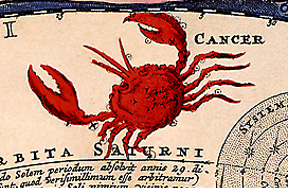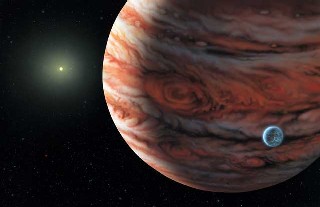This is a picture made by an artist to show what the planet orbiting the star, 55 Cancri, might look like. We do not have photographs of the planet. It is about forty-one light years away from Earth. The artist added a small moon to the picture although no moon has been found.
Click on image for full size
An Exoplanet that Looks Like Jupiter!
News story originally written on June 18, 2002
A team of scientists found 13 planets that are outside our solar system. Because these planets are outside our solar system, they are called exoplanets. One of these exoplanets is special because it may be somewhat like Jupiter. It is orbiting around a star in the Cancer constellation.
Most exoplanets are very close to a star and make small circles as they orbit around the star. This planet is special because it is far away from its star and takes a long time to orbit around it, just like Jupiter.
Jupiter is more than four times further from the Sun than Earth and it takes Jupiter about 12 years to complete one orbit around the Sun. The new planet is a about the same distance from its star and takes 13 years to orbit around the star.
But the new planet is not exactly like Jupiter. It is much more massive than Jupiter and its orbit is a different shape than Jupiterís orbit. The new planet follows a path shaped like an oval as it orbits around the star. The shape of Jupiterís orbit is more like a circle.
Including the 13 exoplanets that this team of scientists just found, there are now more than 90 known exoplanets! The team hopes that they will someday find more exoplanets that are like the planets within our solar system.
Last modified June 24, 2002 by Lisa Gardiner.
You might also be interested in:

According to an ancient Greek legend, the figure of a gigantic crab was placed in the nighttime sky by the goddess Hera to form the constellation Cancer. Hera swore to kill Heracles, the most famous Greek
...more
It was another exciting and frustrating year for the space science program. It seemed that every step forward led to one backwards. Either way, NASA led the way to a great century of discovery. Unfortunately,
...more
The Space Shuttle Discovery lifted off from Kennedy Space Center on October 29th at 2:19 p.m. EST. The sky was clear and the weather was great. This was the America's 123rd manned space mission. A huge
...more
Scientists found a satellite orbiting the asteroid, Eugenia. This is the second one ever! A special telescope allows scientists to look through Earth's atmosphere. The first satellite found was Dactyl.
...more
The United States wants Russia to put the service module in orbit! The module is part of the International Space Station. It was supposed to be in space over 2 years ago. Russia just sent supplies to the
...more
A coronal mass ejection (CME) happened on the Sun last month. The material that was thrown out from this explosion passed the ACE spacecraft. ACE measured some exciting things as the CME material passed
...more
Trees and plants are a very important part of this Earth. Trees and plants are nature's air conditioning because they help keep our Earth cool. On a summer day, walking bare-foot on the sidewalk burns,
...more















